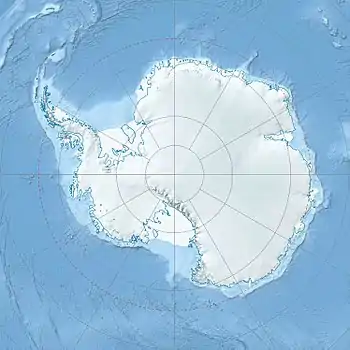| Painted Peak | |
|---|---|
| Highest point | |
| Elevation | 710 m (2,330 ft) |
| Coordinates | 67°45′S 62°51′E / 67.750°S 62.850°E[1] |
| Geography | |
| Location | Antarctica |
| Region | Mac. Robertson Land |
Painted Peak (67°45′S 62°51′E / 67.750°S 62.850°E), also known as Painted Hill, is a prominent peak, 710 metres (2,330 ft), on the northern spur of the North Masson Range in the Framnes Mountains, Mac. Robertson Land.[1] It is the type locality for "Painted Gneiss", which occurs in several parts of the Framnes Mountains and is very different from the predominant Mawson charnockite of the region.
Physical
Painted Peak is in the northern tip of the North Masson Range and rises to 721 metres (2,365 ft). Most of the rocks in the North Masson Range are similar to those at Mawson Station, but the northern tip is made of metamorphosed sediments. Painted Peak is banded with different layers of sediments.[2]
"Painted Gneiss" forms several bodies within the Mawson charnockite of the Framnes Mountains, including Mount Henderson, the Casey Range and Mount Hordern.[3] The metamorphosed gneiss appears to be Precambrian and is certainly not newer than the Mawson charnockite. It is mostly made up of garnet-quartz-feldspar gneiss, contains a considerable amount of biotite-quartz-feldspar gneiss, and has minor amounts of other rock types. Painted Peak is one of the largest bodies of this gneiss and is designated as the type area. At Painted Peak the gneiss is about 300 metres (980 ft) thick, but this thickness may be partly due to folding.[4]
Biology
Lichens found on Painted Peak include:[2]
- Acarospora gwynnii
- Acarospora wiliamsii
- Biatorella antarctica
- Buellia frigida
- Buellia aff. subpedicellata
- Protoblasienia citrina
- Lecanora rubina var. melanophthalma f. exulans
- Lecanora expectans
- Lecidea phillipsiana
- Rhizocarpon flavum
- Omphalodiscus decussatus
- Alectoria minuscules
Exploration
Painted Peak was mapped by Norwegian cartographers from air photos taken by the Lars Christensen Expedition, 1936–37. Visited by an ANARE (Australian National Antarctic Research Expeditions) party in 1955, and so named because of its conspicuous red-brown coloring. Not: Painted Hill.[1] In 1966 the peak was used as a tellurometer station.[2]
References
- 1 2 3 Alberts 1995, p. 553.
- 1 2 3 Filson 1966, p. 23.
- ↑ Trail 1970, pp. 13–14.
- ↑ Trail 1970, p. 14.
Sources
- Alberts, Fred G., ed. (1995), Geographic Names of the Antarctic (PDF) (2 ed.), United States Board on Geographic Names, retrieved 2023-11-07
 This article incorporates public domain material from websites or documents of the United States Board on Geographic Names.
This article incorporates public domain material from websites or documents of the United States Board on Geographic Names. - Filson, Rex B. (1966), The Lichens and Mosses of Mac. Robertson Land (PDF), Antarctic Division, Department of External Affairs Australia, retrieved 2023-11-28
- Trail, D.S., Series A (III) Geology Publication No. 116 (PDF), ANARE Interim Reports, Australian National Antarctic Research Expeditions, retrieved 2023-12-02
